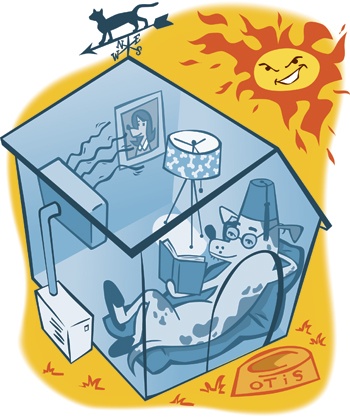Air conditioning is the biggest energy user in most U.S. homes. Each month, cooling and heating costs make up about half of a typical electricity bill. Two-thirds of U.S. homes have air conditioners, and homeowners collectively spend more than $11 billion on cooling costs per year, reports the U.S. Department of Energy.
Homes typically have central air conditioners or room units. Central air conditioners circulate cool air into the home through a system of supply and return ducts, while room air conditioners regulate temperature in a smaller space. Regular maintenance can help these systems run more efficiently, but switching to a ductless system can save money and increase comfort and control.
Ductless systems, also called mini-split air conditioners, have been around for about 30 years and are used worldwide. Like central air conditioners, these systems use outside compressors or condensers, but they also typically have one to four indoor blowers mounted inside that provide zoned cooling.
Pros
In traditional air-conditioning systems, about 20 percent of the air moving through the duct system is lost to leaks, holes and poor connections. Investing in an Energy Star-rated ductless model, which eliminates such air loss, could cut energy costs by 30 percent, according to the DOE.
The ability to power up units individually to cool only occupied rooms or zones rather than the whole house can also save energy. Each ductless air-conditioner unit has its own thermostat, and some models can be controlled by remote control.
Ductless air conditioners are often used in buildings without built-in ductwork, such as homes constructed before the advent of central air. The design allows adding air conditioning without tearing into walls to install ducts. The systems are also popular for replacing noisy, hard-to-seal window air conditioners or for better cooling rooms poorly served by central air units.
But ductless systems aren’t just for retrofits or supplemental cooling. They’re found in new construction, including houses, multifamily units and home additions. The units’ small size and versatile mounting options make them practical for some of these applications.
Cons
The biggest drawback is the initial cost, generally about 30 percent more than a central air-conditioning system, according to the DOE. Also, large homes might require more than one condenser, warns Consumer Reports. And ductless systems can cost double what you’d spend on window air-conditioning units.
Plus, installation can be tricky: Measuring the space—a room or zone—and the units’ capabilities can be a difficult process: Ask a professional for help. And if they don’t match up, cooling and humidity control won’t be as effective, and energy will be wasted.
——————–
Suzanne Haberman, staff writer


